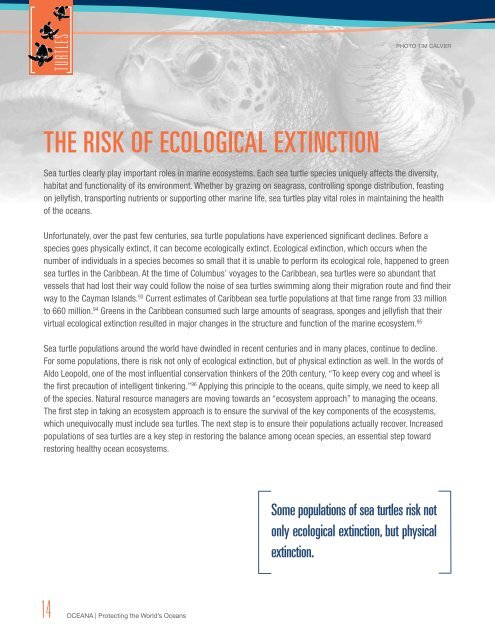Why_Healthy_Oceans_Need_Sea_Turtles
Why_Healthy_Oceans_Need_Sea_Turtles
Why_Healthy_Oceans_Need_Sea_Turtles
Create successful ePaper yourself
Turn your PDF publications into a flip-book with our unique Google optimized e-Paper software.
TURTLES<br />
PHOTO TIM CALVER<br />
THE RISK OF ECOLOGICAL EXTINCTION<br />
<strong>Sea</strong> turtles clearly play important roles in marine ecosystems. Each sea turtle species uniquely affects the diversity,<br />
habitat and functionality of its environment. Whether by grazing on seagrass, controlling sponge distribution, feasting<br />
on jellyfish, transporting nutrients or supporting other marine life, sea turtles play vital roles in maintaining the health<br />
of the oceans.<br />
Unfortunately, over the past few centuries, sea turtle populations have experienced significant declines. Before a<br />
species goes physically extinct, it can become ecologically extinct. Ecological extinction, which occurs when the<br />
number of individuals in a species becomes so small that it is unable to perform its ecological role, happened to green<br />
sea turtles in the Caribbean. At the time of Columbus’ voyages to the Caribbean, sea turtles were so abundant that<br />
vessels that had lost their way could follow the noise of sea turtles swimming along their migration route and find their<br />
way to the Cayman Islands. 93 Current estimates of Caribbean sea turtle populations at that time range from 33 million<br />
to 660 million. 94 Greens in the Caribbean consumed such large amounts of seagrass, sponges and jellyfish that their<br />
virtual ecological extinction resulted in major changes in the structure and function of the marine ecosystem. 95<br />
<strong>Sea</strong> turtle populations around the world have dwindled in recent centuries and in many places, continue to decline.<br />
For some populations, there is risk not only of ecological extinction, but of physical extinction as well. In the words of<br />
Aldo Leopold, one of the most influential conservation thinkers of the 20th century, “To keep every cog and wheel is<br />
the first precaution of intelligent tinkering.” 96 Applying this principle to the oceans, quite simply, we need to keep all<br />
of the species. Natural resource managers are moving towards an “ecosystem approach” to managing the oceans.<br />
The first step in taking an ecosystem approach is to ensure the survival of the key components of the ecosystems,<br />
which unequivocally must include sea turtles. The next step is to ensure their populations actually recover. Increased<br />
populations of sea turtles are a key step in restoring the balance among ocean species, an essential step toward<br />
restoring healthy ocean ecosystems.<br />
Some populations of sea turtles risk not<br />
only ecological extinction, but physical<br />
extinction.<br />
14 OCEANA | Protecting the World’s <strong>Oceans</strong>















